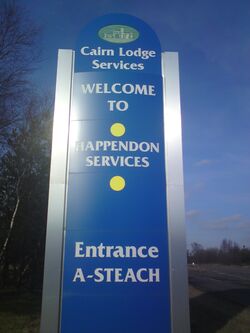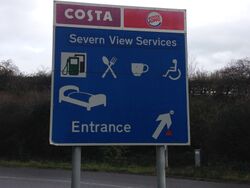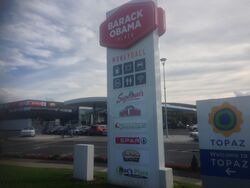How are motorway services named?

Today, service stations are developed by the private sector who can use whatever name they like. Generally, developers like to use names that refer to well-known places, for reasons that are explained further down.
There is a rule that the name which is used on road signs must be a "geographical" name, but that's a very vague rule which has allowed Cairn Lodge, The Buck and Family Farm to be used. Motorway service areas must have an official geographical name provided, but A-road service areas can remain anonymous if they prefer.
There are two examples of services which were promoted under a brand name and then changed to a specific one: Gloucestershire Gateway became Gloucester in 2014, and Stop 24 became Folkestone in about 2010. This suggests that the vague "geographical" rule may have some weight.
The oddest service area name in the UK is probably Pont Abraham. It is named after a bridge that no longer exists, and that bridge was named only in Welsh.
Government documentation uses a number of fictional names as placeholders, to avoid inadvertently promoting a service area.
Complications
Each individual brand will want to refer to their branch by a name that is unique to their business. This means one particular service area may be promoted under several different names. In particular, petrol stations that have been there a long time may still use the name of a local landmark that is no longer relevant, while hotels will want to use the name of a major landmark.
Locals to the area may prefer to use a local nickname, and if you're looking through the history then there is another name to look out for: during development, service areas are often known by the farm on which it is going to be built on.
Naming after a major city can cause complications when new service areas open. There are at least three services which want to be known as Doncaster, while Welcome Break's Peartree is closer to Oxford than their own Oxford services. Signed service areas will try to make each name unique, while each individual operator will want to avoid any duplication within their own estate.
In 2012, the List Sign was changed to use service area names rather than operator names. This can cause confusion when names of far-away cities are used.
History

For the first 25 years, motorway service areas were planned by the government. The Ministry of Transport (and their many successors) would give each service area a very precise name, to identify it from other possible sites. That name would then be written in the contract.
As they owned the land, the Ministry had the final say in what went on the road signs, although they were willing to discuss any name concerns with the operator and the local authority. The contract for 'Cutsey services' opened as Taunton Deane, and 'Sandy Gate services' opened as Exeter.
This relationship changed in 1992. Motorway service areas were able to own their own land, in exchange for paying for new road signs on the motorway. The service areas soon made one thing clear: they wanted those signs to have the names of cities, not obscure villages.
One reason for this preference was that it made it easier to promote the business, especially the hotel. A new name was also an opportunity to shake-off a bad reputation. However, according to one Granada insider, the main benefit of using a less precise name was that it allowed them to claim a larger corner of the motorway network. For example, if Trowell services became "Nottingham services", it could then be expanded on the basis that it was the only service area needed in the Nottingham area.
A few names were changed early on, mostly by Pavilion. Name changes became a big news story in June 1996, when it was reported that as many as one-in-five motorway service areas could be about to change their name. Granada and Roadchef were both quoted saying they were unhappy with the historic names they had inherited. Granada had nine new names approved, but poor media coverage meant their process was stopped. The Sunday Telegraph had criticised the spread of "mundane new titles".
Meanwhile, some service areas didn't want to convince you they were near a big city, but instead were trying to paint a relaxing image of pleasant greenery. That's why some 1990s developments chose names like Cherwell Valley, Birchanger Green and Hopwood Park. In the 2010s those cumbersome names started to be dropped, with Gretna Green and Donington Park losing their suffixes.
In March 2020, Leeds Skelton Lake became the only motorway service area to have two names in its official title. Skelton Lake is in Leeds.
Contentious Names
The very first service area can also claim the very first fight over a name: Watford Gap could have been called Watford, Welton or Watford Village.
In 1970 Washington was one of the first service areas to be named after a large town, which ruffled the feathers of Chester-le-Street Rural District Council, who wanted it to be named after them.
One of Granada's many renamings was their suggestion that Hilton Park was "Birmingham North", which caused irritation because it's in Wolverhampton. Likewise Blackburn was reluctantly renamed Blackburn with Darwen, after complaints from locals.
The decision to name the hotel at Sarn Park, "Days Inn Bridgend-Cardiff" received similar criticism from the proud town of Bridgend.
Different Sides
When a service station has two buildings on either side of the road, most staff know the buildings by where they are, not where the road goes. Thus Frankley northbound is known internally as "Frankley West" because it is to the west of the M5, even though the road is going north.
This becomes especially confusing when a road turns. Thanks to a bend in the M6, at Corley the building to the north of the road ("Corley North") serves the M6 southbound. Winchester is another example, where the western half ("Winchester West") serves the side of the M3 that will take you east. Keele is an even more pedantic example.
Changed Names
The following motorway service areas have had their official name changed over the years. This only shows the names that were used on road signs, so it excludes names that were only used during planning.
The name changes have generally happened in a few waves: firstly Pavilion going for more fashionable names in around 1993, then Granada using big city names in 1996, and more recently the change of road signs in 2012 allowed a few more service areas to shorten their name.
In the case of Granada, there were many alternative names that they used on leaflets, and at least nine name changes that they had approved. This list only shows the ones that are likely to have happened.
| Services | Previous Name(s) | Year / Period |
|---|---|---|
| Birch | Manchester North (change was approved, not clear if it happened) | 1996 |
| Blackburn with Darwen | Blackburn Interchange, Blackburn | 2005 |
| Burton-in-Kendal | Burton West | 1996 |
| Cairn Lodge | Happendon | 2018 |
| Donington | Donington Park | 2016 |
| Frankley | Birmingham South (change was approved, not clear if it happened) | 1996 |
| Gretna | Gretna Green | 2010 |
| Heart of Scotland (Harthill) | Harthill | 2006 |
| Hilton Park | Birmingham North | 1996 |
| Lancaster | Forton, Lancaster (Forton) | 1996 |
| London Gateway | Scratchwood | 1999 |
| Medway | Farthing Corner | 1993 |
| Northampton | Rothersthorpe | 2002 |
| Rivington | Anderton, Rivington, Bolton West, (Chorley never signed), Rivington North/South | 1992, 1996, 2011 |
| Sedgemoor | Brent Knoll (as a rest area) | 1986 (but that's when it opened) |
| Severn View | Aust | 1993 |
| Tibshelf | Chesterfield (change was approved, not clear if it happened) | ?? |
| Washington | Washington-Birtley (Port/Virgo never signed) | ?? |
As most A-road service areas aren't named on road signs, there is often no consensus on what they are called, making it difficult to trace any changes. There are some examples though, for example what Shell currently call Buckingham services was called 'Mount Pleasant' by Fina. Similarly, what's widely known as 'Boreham services' has an old sign calling it Chelmsford.
Ireland

Official (online) services in Ireland are planned by the government, and use local names coupled with the motorway number.
Unofficial (offline) services are named by developers, and usually refer to larger settlements like Wicklow. The road signs never use these names, except on the M11 where a comparison with other services is required. In that case the signs refuse to use the Wicklow name, and call it Coyne's Cross instead.
In particular, Supermac's like to use branded names. It remains to be seen what the road signs will make of Barack Obama Plaza.